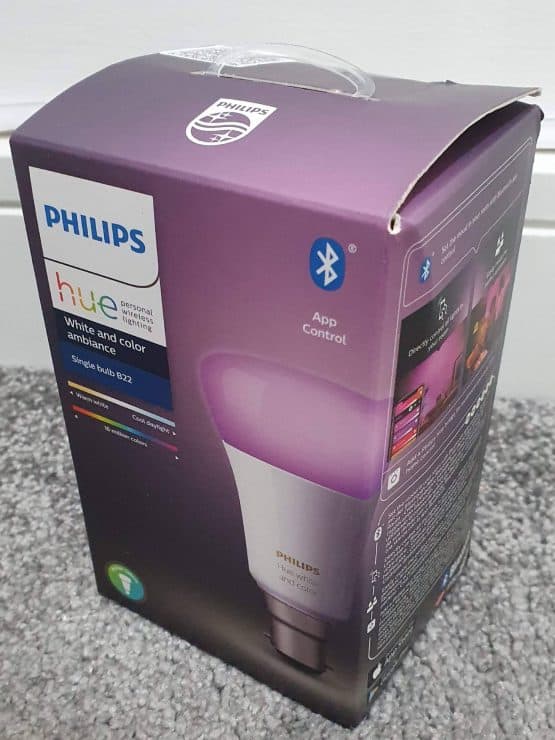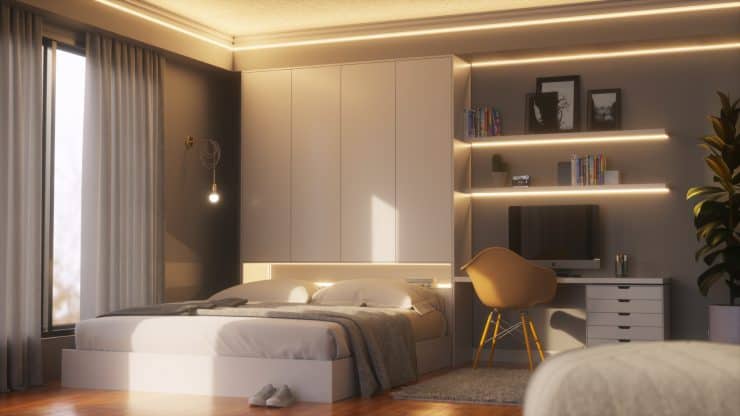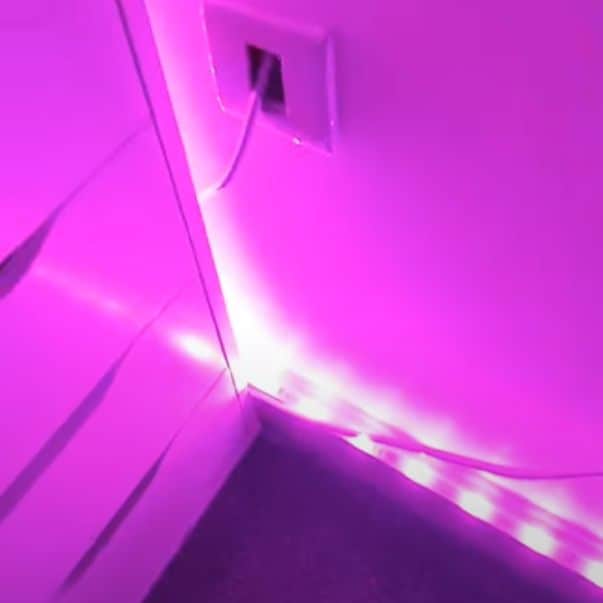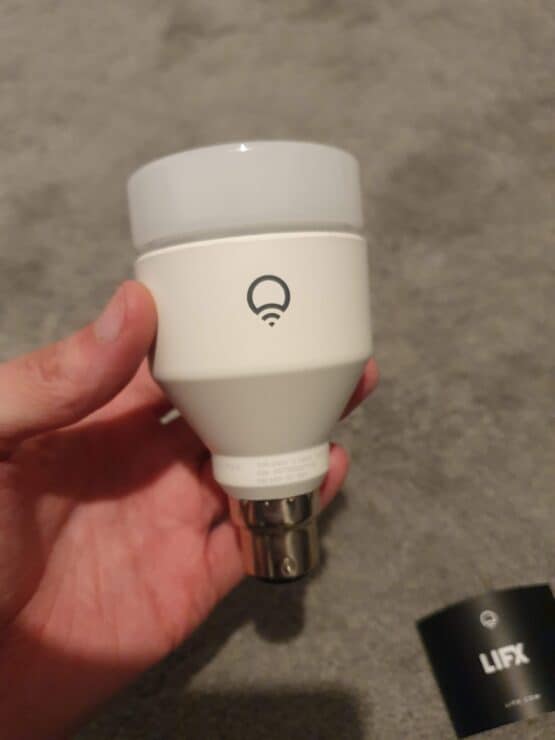Philips Hue has an extensive line of smart lighting products that provide varying degrees of lighting for the modern smart home. Their diverse range of lighting products includes a variety of bulbs for both the inside and outside of your home.
Their line also includes floor lights, light strips, pendant lights, and even their lighted play bars that can be used to enhance your TV viewing and video gaming experience.
Their smart bulbs come in different shapes and colors, including different variations of warm and cool whites. They even offer filament bulbs should you decide you want a non-LED option.

Philips Hue’s Light Strips, Play Bars, and even Table Lights further enable you to customize the look and feel of your home.
With all of these options, many people that either already use Philips Hue smart lighting, or are considering doing so, may wonder – what Philips Hue products would light their home best, and why?
In answering that, there are a few different factors to consider.
How many Lumens do you Need?
In order to better understand how the brightness of Philips Hue’s bulbs and products will light the typical home, it would be best to first take a look at a scenario of what adequate lighting and lumens would be.
Consider a room such as the Family or Living Room. The average Family Room is about 16 x 20 feet or 320 square feet. When it comes to lumens, most experts recommend about 10 – 20 lumens per square foot. With this equation, at 320 square feet, the average Living Room would need anywhere from 3,200 to 6,400 lumens.
To achieve this brightness, one option is to use 4 – 6 bulbs at 800 lumens each. Some Philips Hue lights can provide up to 3,000 lumens per fixture – so in this case, you would only need 2. The amount of lights or bulbs you need would depend on the lumen output of each bulb or light fixture.
Of course, this is only a general guideline, and can be adjusted according to your preference. Perhaps you don’t want the Family Room – or any other room for that matter, to be quite that bright. In that case, you would adjust according to what looks and feels right for you and your home.
How bright are the Philips Hue bulbs?
Now that there’s a general outline for what may work best to light your home, it’s time to take a look at what Philips Hue has to offer in terms of their line of bulbs.
For starters, take a look at Hue’s line of E26 bulbs. These bulbs typically fit into standard lighting sockets and come in different bulb shapes such as BR30, A19, A21, and G25. While they all fit into standard light sockets, the bulbs themselves are different shapes and have differing lumen outputs depending on the size and color.

For example, the basic E26 color and white bulbs come in at 800 lumens – no brighter than your average 60-watt light bulb. For many people this isn’t a problem – simply being able to control their lights including the brightness and color wirelessly is convenient enough. For others, they may prefer something a tad brighter.
The E26 BR30 bulbs, with their wider brim at the top, come in at 650 lumens for the white and color ambiance. Then the A19 and G25 filament bulbs come in lower at 530 lumens.
The E12 – though not for standard sockets, only emits 450 lumens per bulb.
So until Philips Hue release some brighter bulbs (possibly due September 2021), the current bulb brightness levels can be summed up as:
| Philips Hue Bulb | Brightness (Lumens) |
| Hue E26 White And Color | 800 lumens |
| Hue E26 BR30 White And Color | 650 Lumens |
| Hue A19 and G25 | 530 lumens |
| Hue E12 | 450 lumens |
| Hue GU10 (Spotlights) White And Color | 400 Lumens |
Some smart home users have gotten a little confused when it comes to terms such as A19, E26, E12 and so forth.
A19, A21 and E26 bulbs – the three most common bulbs offered by Philips Hue, are usually interchangeable, and fit in most standard light sockets. This also goes for the filament versions. However, there is a word of caution when it comes to A21 bulbs.
These bulbs are slightly bigger than their A19 counterparts, so while an A19 bulb can be placed into an A21 socket, the same may not always be true vice versa. One reason this may be the case is if the A19 lamp has a smaller lamp head, thereby being unable to accommodate the larger A21 bulb. They also shouldn’t be placed in a smaller lamp where they’ll sit too close to the lamp shade, as it could potentially be a fire hazard.
In terms of the E12 bulbs, these have a smaller base and usually fit in more decorative lighting such as chandeliers.
Another popular Philips Hue bulb is the GU10. They come in two varieties; White and White Ambiance, and White and Color Ambiance.

The White and Color Ambiance has an output of 350 lumens, while the White and White Ambiance comes in slightly brighter at 400 lumens.
Is the Philips Hue Go bright enough?
The Philips Hue Go is a portable light that can work either as a standalone light, or with the rest of your Philips Hue lights via the Hue Bridge. They can be either plugged into the wall with the included power adapter, or used wirelessly with the integrated battery.
These conveniently portable lights can be used to add a pop of color to any room in your home, or be used to provide some light whereas it’s not normally available. They can be brightened, dimmed, and even change colors to your preference via the Hue app.
However, it would be best to not rely solely on these bulbs for general, everyday lighting. Each Philips Hue Go bulb emits only 520 lumens per bulb – not quite enough for general lighting, even if you add a few bulbs to the mix.
These bulbs are best used in conjunction with other Philips Hue lighting options, or when no other lighting is available, such as if you happen to be entertaining outdoors at night.
General Lighting vs. Ambient Lighting

The difference between General Lighting and Ambient Lighting depends on the types of activities that the lighting is used for.
General Lighting is used for more typical daily activities such as cooking, cleaning, doing homework, or working from your home office. This provides the most lighting for visibility for whatever you’re doing.
The aforementioned equation regarding 10 – 20 lumens per square foot of space is a good general rule to follow when it comes to general lighting. This guideline helps you determine the best lighting for your particular space.
In terms of ambient or mood lighting, this type of lighting is more suited for relaxing, gaming, or entertaining guests.
The soft, subdued tones of ambient lighting are conducive to relaxing after a long day at work, school, or any other activity you’ve taken part of during the day. It sets the mood for the evening, and can even be used to set the tone for a relaxing dinner with the family.
This type of lighting is also great for entertainment, such as lighting that mimics the rhythm of music you’re playing, or to enhance the lighting in the room for a movie night or video games.
Philips Hue Products for General Lighting
Because of their lumen output, using only Philips Hue’s bulbs may not always be sufficient or practical for general, everyday lighting. Though they don’t use a lot of power, using 4 – 6 bulbs just to light one room may not be ideal on the wallet. However, using them in conjunction with some of Philips Hue’s other lighting products could prove beneficial.
Take into consideration Philips Hue’s line of Ceiling and Pendant Lights. The Being Pendant light, for example, puts out a brilliant 3,000 lumens! These lights not only provide adequate lighting for your activities, but their elegant design brings a touch of style to any room they’re in.
In fact, most of Hue’s Pendant and Ceiling lights have a high lumen output – anywhere from 2,400 to 3,000 lumens.
Philips also has Floor lamps that provide about 2,000 lumens of light. These floor lamps, just like the Ceiling and Pendant lights, can be customized to provide bright light in either white, or a variety of colors – all completely customizable in the Hue app.
Of course, with a higher lumen output also comes a higher price tag. But many find the price worth it for style, convenience, and the ability to curate the perfect lighting.
Philips Hue Products for Ambient Lighting
Many of the same products that can be used for general lighting, can also double as ambient lighting. One such example is Philips Hue’s pendant lights. Just as its namesake, these lights hang elegantly from your ceiling, adding the perfect touch to your dining room, or even a sunroom as you enjoy a relaxing evening.
The Downlights, at about 350-400 lumens each, provide soft, ambient lighting wherever they’re placed. They come in either 4, or 5-6 inch versions, and you can easily customize the lighting in the Hue app.
Lighting strips remain one of the most popular options for mood lighting, especially when it comes to entertainment. Many people place them around the TV, or any sound system they may have in place. They can be set to react to the rhythm of music, and even video games.

Much like the light strips, the Hue Play Bar is also used to enhance your entertainment experience. They operate much like the lighting strips, without the need to be attached to the wall or any device. This colorful bar can also be set to react to the rhythm of music, video games, and movies. One major advantage that the Play Bar has over lighting strips, is its portability. You can easily move it around without having to deal with any adhesives.
While some lights may be particularly appealing, all of Philips Hue’s lighting can be used to provide ambient lighting, as long as you have the Hue app, and in most cases, the Hue Bridge. Once connected, you can control and customize all your lighting to create the mood you’re looking for.
Should you use LIFX or Nanoleaf instead?
Each manufacturer, though they produce similar products, has their own advantages and disadvantages.
For example, think about general lighting. Many of LIFX’s A19 bulbs, at up to 1100 lumens per bulb, have the advantage over Philips Hue which only offers 800 lumens per bulb – with the exception of the A21.

Enter Nanoleaf. They compete fairly with LIFX, at 1100 lumens per bulb, leaving Philips Hue behind. Coupled with the Nanoleaf bulb’s intricate, geometric design, they’re often a big win in most smart homes.
Now consider ambient lighting. It’s in this category when the competition gets tough, and the decision ultimately hangs on what your particular lighting preferences – and budget – are.
While Nanoleaf provides the most creative and intriguing ambient lighting option with their extensive line of decorative wall panels – the price often makes people shy away.

Then comes Philips Hue. Their line of smart lighting is by far one of the most varied – and keeps growing. Not only do they have bulbs in varying shades of white, as well as many different colors, but they also have play bars that can work with your entertainment system, light strips, pendant lights – and so much more.
When it comes down to it, the decision hinges on what works best for your smart home.
Smart Lighting Your Way
At the end of the day, your choice of smart home lighting is dependent on what you’re looking for in terms of color, brightness, convenience – and price.
Are you more in need of general lighting or ambient/mood lighting? What is your budget? How important is a particular style to you? Do you need your lighting to work with a specific smart home hub?
All of these are factors to be weighed and considered when you decide which smart light manufacturer and lighting product to go with.
Torn between a few different lighting products? No problem – there are no rules saying you can’t own devices from more than one manufacturer! With so many options, your choices are endless.

If you have any questions, feedback or suggestions about this article, please leave a comment below. Please note that all comments go into a moderation queue (to prevent blog spam). Your comment will be manually reviewed and approved by Tristan in less than a week. Thanks!